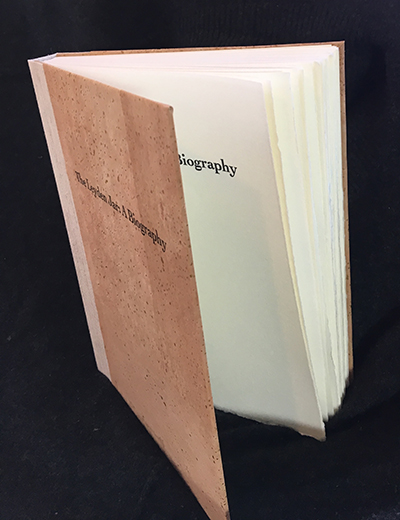The Leyden Jar Project includes an extended essay presented in a more traditional book format. Written by Karen Pava Randall, the book details the birth of the Leyden Jar in the mid-eighteenth century, its maturation in the nineteen century, and its central role in the discovery of fundamental laws of physics. The 106 page text, The Leyden Jar: A BIOGRAPHY, is letterpress printed and hand-bound.

An excerpt:
"The magic of the Leyden Jar may have worn off over time as it metamorphosed from object of beauty and fascination to an everyday workhorse in the nineteenth century electrical physicist’s laboratory, and yet, it still harbored secrets. Under Michael Faraday’s watchful gaze, the Leyden Jar at last breathed forth the source of its elusive charms. Faraday’s nearly 30 years of electrical experiments would form the basis, along with James Clerk Maxwell’s mathematical underpinnings, of modern electromagnetic field theory. The Maxwell-Faraday theory was a bridge not only to Albert Einstein’s insights into relativity, but also lay the theoretical groundwork for the development of radio technology."
A summary of the material covered in the biography
The pre-history of the Leyden Jar begins with amber: "In his book, De Magnete, published in 1600, William Gilbert, the English natural philosopher and attendant physician to Queen Elizabeth I, borrowed the word electric from the Greek word for amber (ελεκτρον, electron) to refer to any object that attracted small bits of light-weight material such as straw when rubbed. "
Following an exploration of the discovery (or invention if you prefer) of the Leyden Jar, I discuss Benjamin Franklin's contributions to the understanding of the nature electricity and the Leyden Jar. I argue that Franklin's later success as an American diplomat in Paris had much to do with having earlier established his fame as a scientist.
I then proceed to discuss another book artist's contributions to electrical science: Michael Faraday. Just as Franklin got his professional start as a printer, Michael Faraday was apprenticed to a book binder before entering the grand halls of science. Faraday's contributions to our modern understanding of how electricity works are vast. Not only did he expand our understanding of the relationship between electricity and magnetism (and thereby pave the way for electro-magnetic motors), it was Faraday that finally solved the mystery of the Leyden Jar through his work with a sort of variable capacitor. Swapping out the material between the outer surface of one metal globe and the inner surface of the larger one encompassing it, he discovered that the capacitive properties of various materials varied. That is to say different dielectrics [a word coined by Faraday's polymath friend William Whewell for referring to materials that could hold an electric charge] materials could hold different amounts of electricity.
In the last chapter I discuss the Maxwellians. The success of Faraday's discoveries becoming the dominant theoretical model depended in large part on the mathematical contributions of James Clerk Maxwell. However, Maxwell's equations were themselves very complex; it was his successors, the four Maxwellians (the Brits: George Francis Fitzgerald, Oliver Lodge, and Oliver Heaviside, and the German: Heinrich Hertz) that made the Faraday-Maxwell theories accessible. The crowning glory, of course, was Hertz's transmission and reception of radio waves using a Leyden Jar, a dipole antenna, and a Ruhmskorff coil. Sending oscillating electromagnetic waves across the room and reflecting them back, Hertz was able to create a standing wave and measure its length. Effectively, Hertz proved that Maxwell had been correct in theorizing that electromagnetism was a wave and that it not only traveled at the speed of light: light was a form of electromagnetism.
All of these ideas are covered in much greater detail in the book.
The Biography also includes an appendix on glass technology in relation to the development of the Leyden Jar as well as many other excursions. Some other appendices are here:
Key Figures in the History of the Leyden Jar
Key Concepts Related to the Leyden Jar
The Colophon:
"Created in an edition of twelve (of which ten are for sale), the Leyden Jar Project sculptures consists of acrylic box fabricated by Todd and Ian Harris of 42 Design Fab in Indian Orchard, Massachusetts. The glass jars were blown by Forrest Whitcher in the MIT glass studio in Cambridge, Massachusetts. The translucence of the acrylic and the glass are contrasted by the bands of gold (leaf over copper foil) encircling each of the jars. These conductive metal surfaces are connected to an Arduino microprocessor stored in a compartment below the bottom shelf of jars. When a jar is touched, a signal is sent to the microprocessor, which causes it to play a recording of one of the thirty-six poems in this book; each jar ‘contains’ three poems, which are played according to the length of time that the jar has been touched. The sculptures were assembled and programmed by Karen Pava Randall at her studio in Northampton, Massachusetts is housed in a clamshell box measuring 7.5 by 9 by 16. Beneath a panel in the box are additional items: a solar panel and a transformer cable which can both be used to recharge the Leyden Jar Project’s battery."